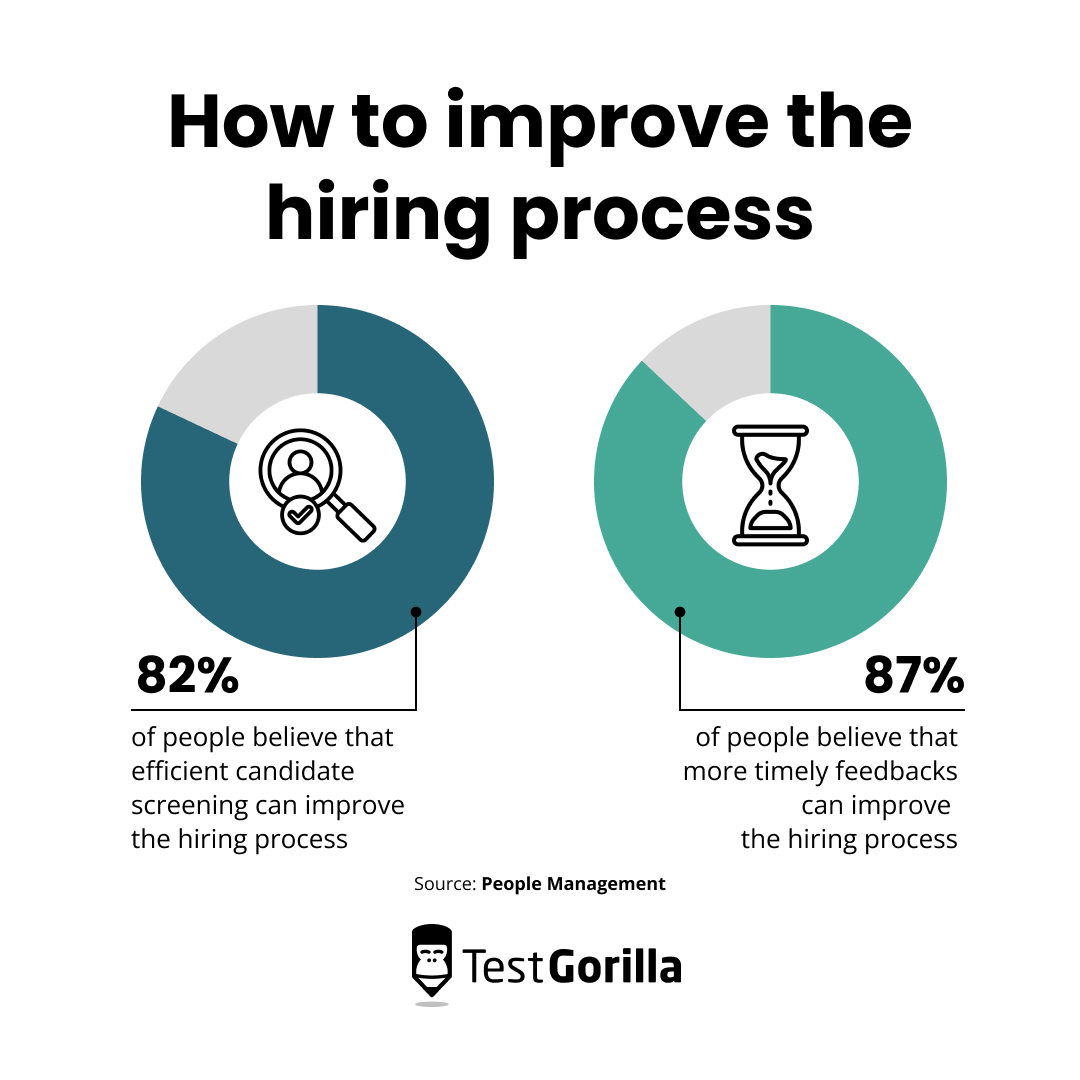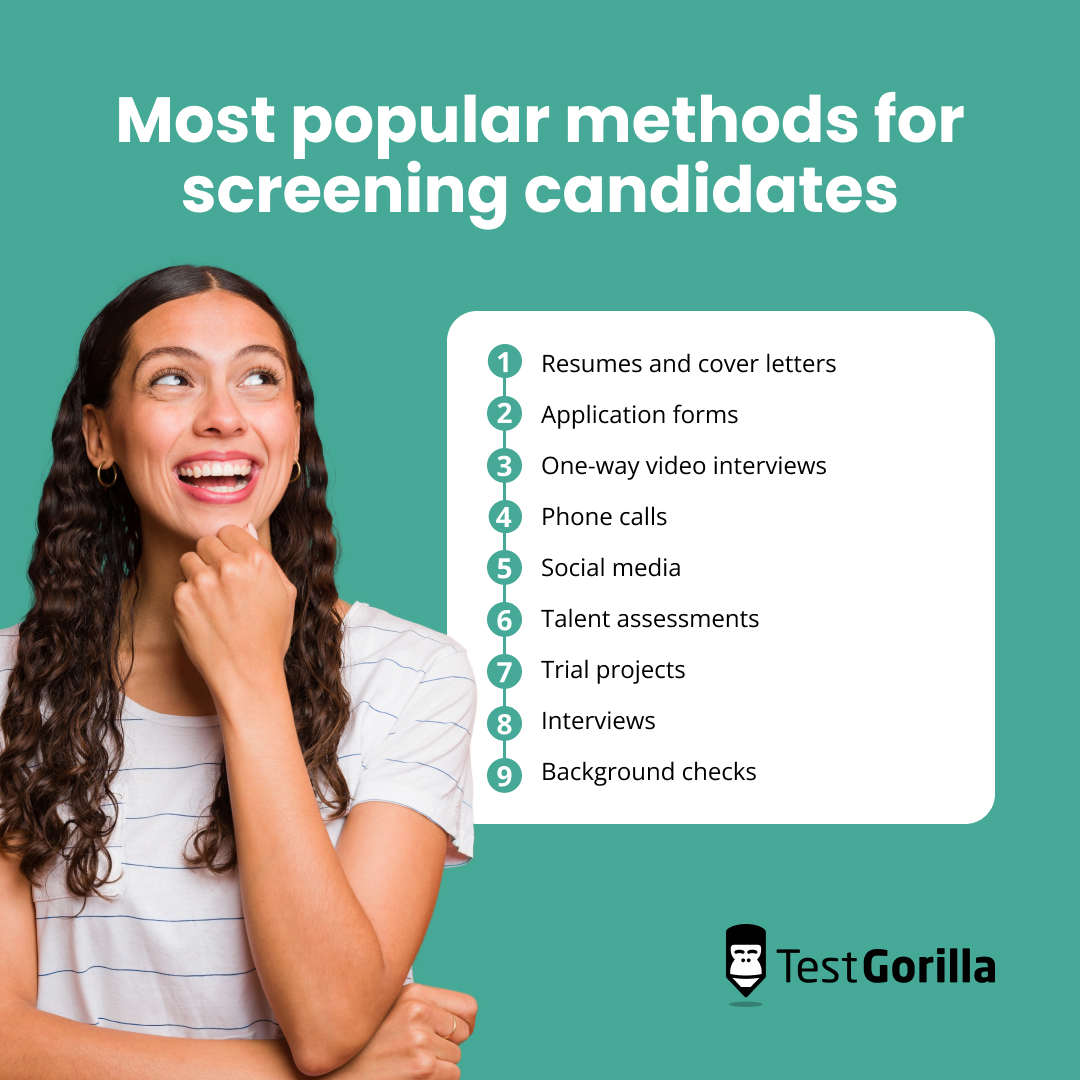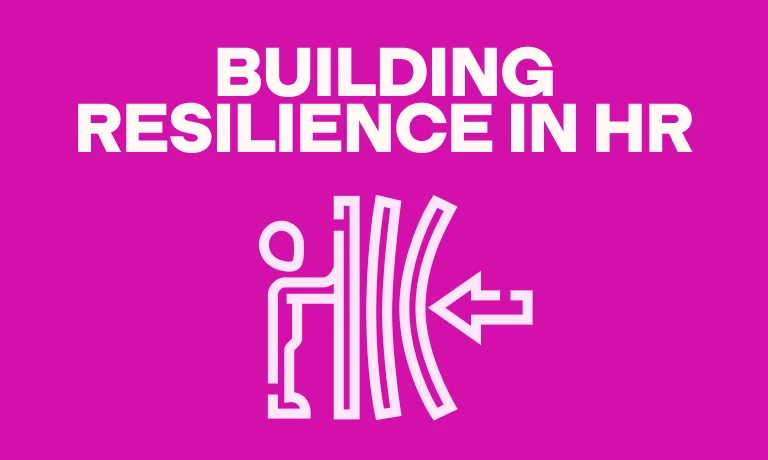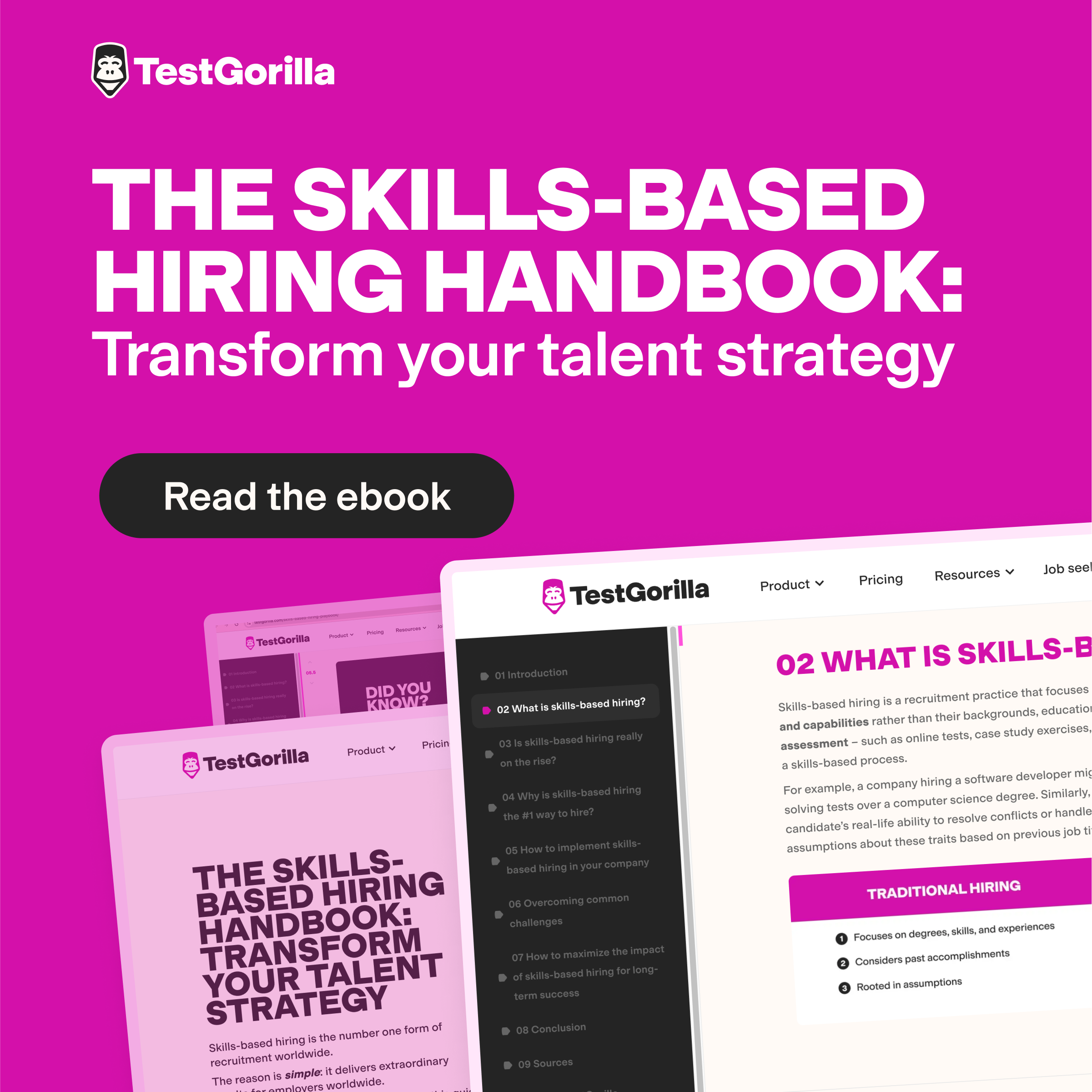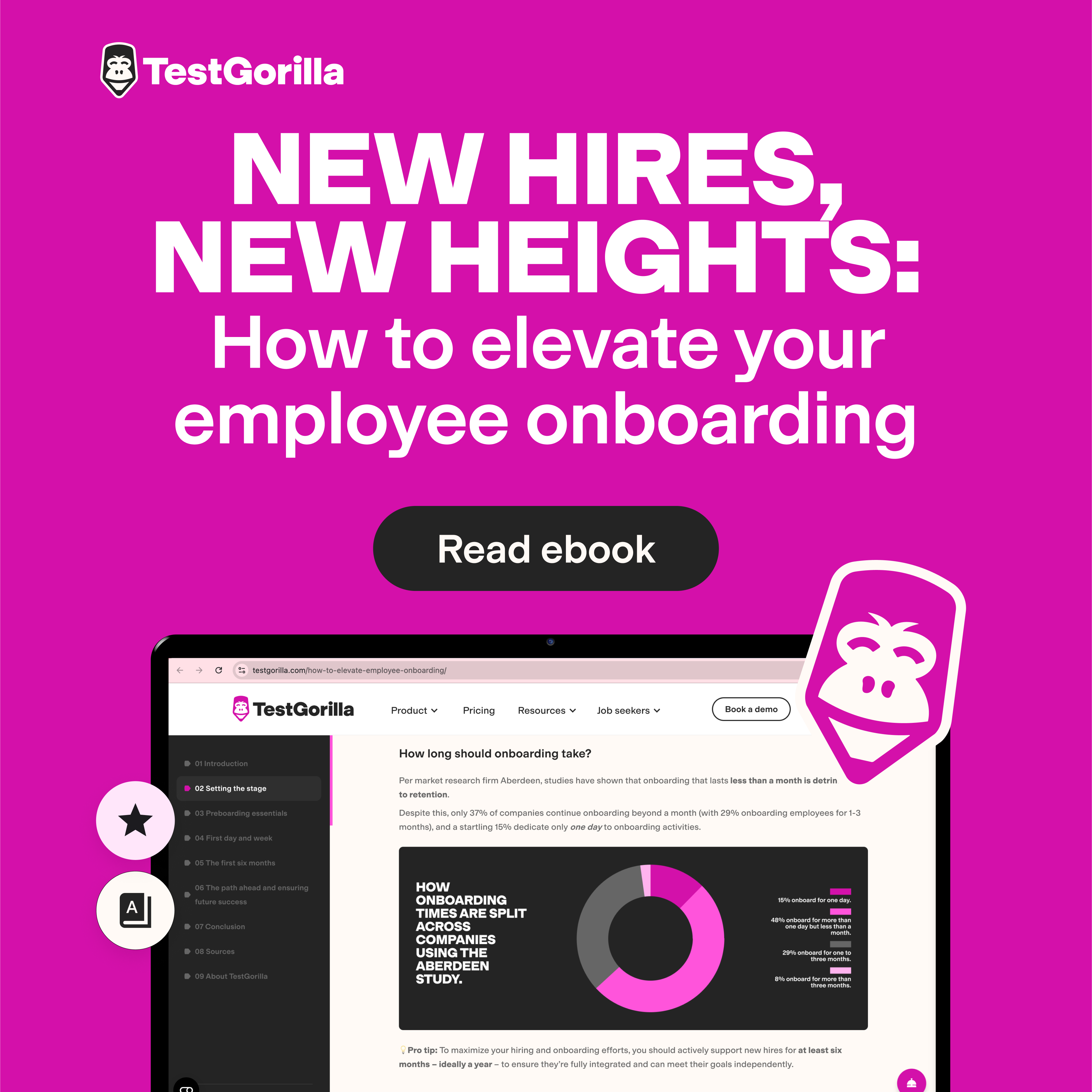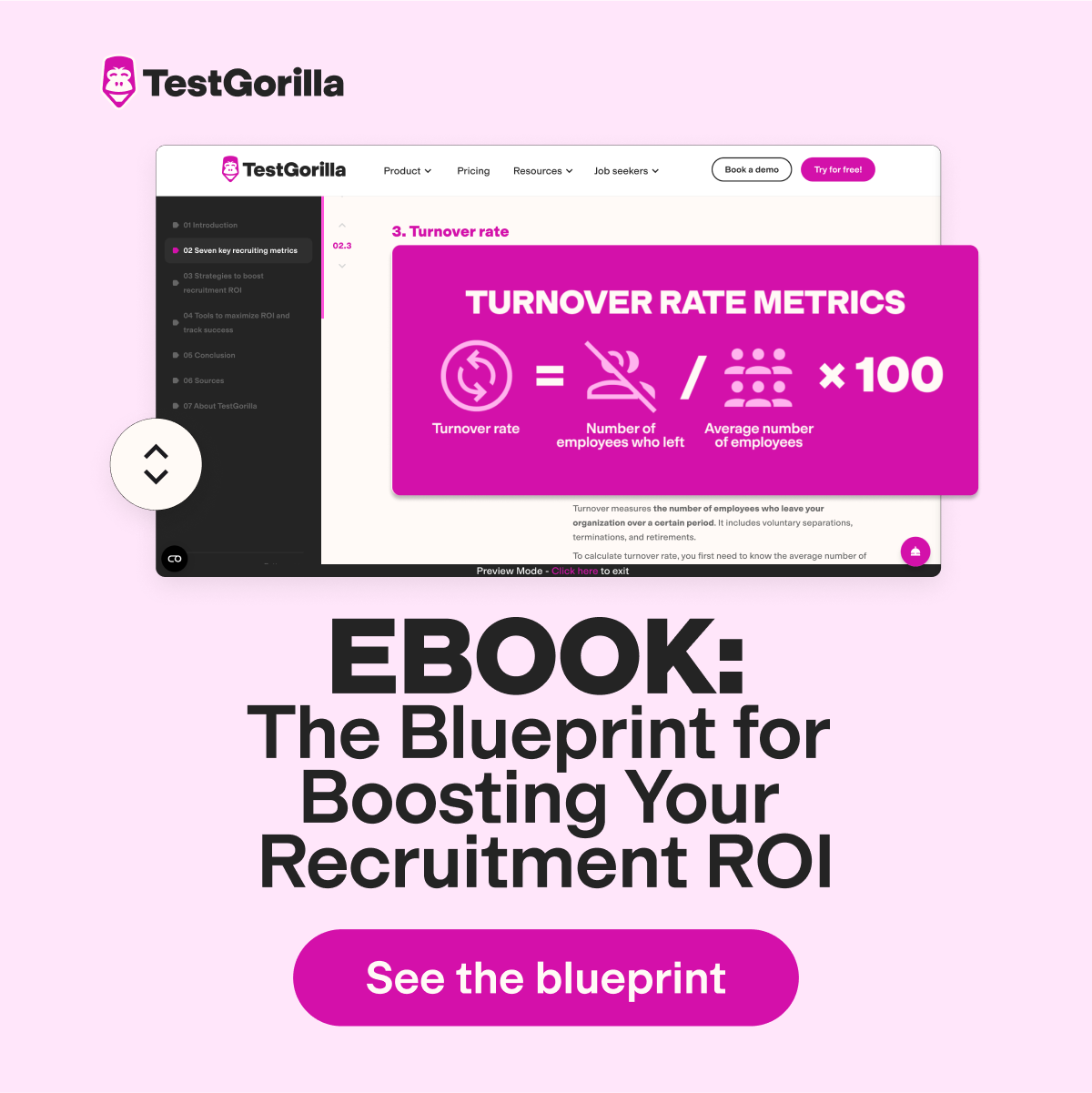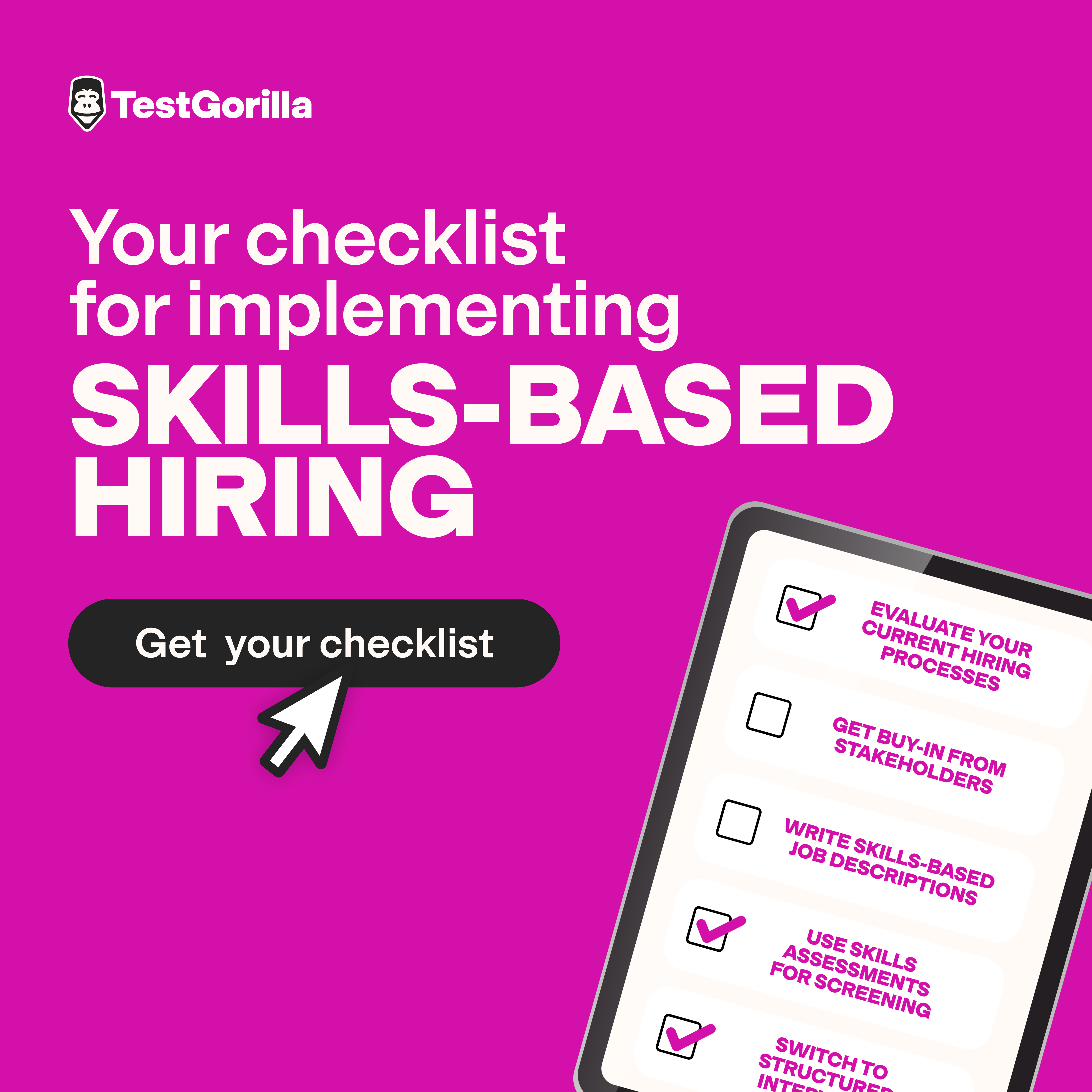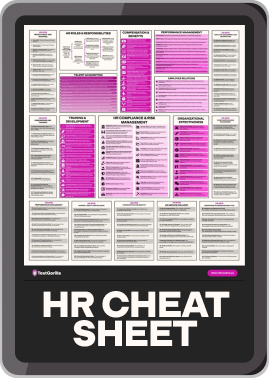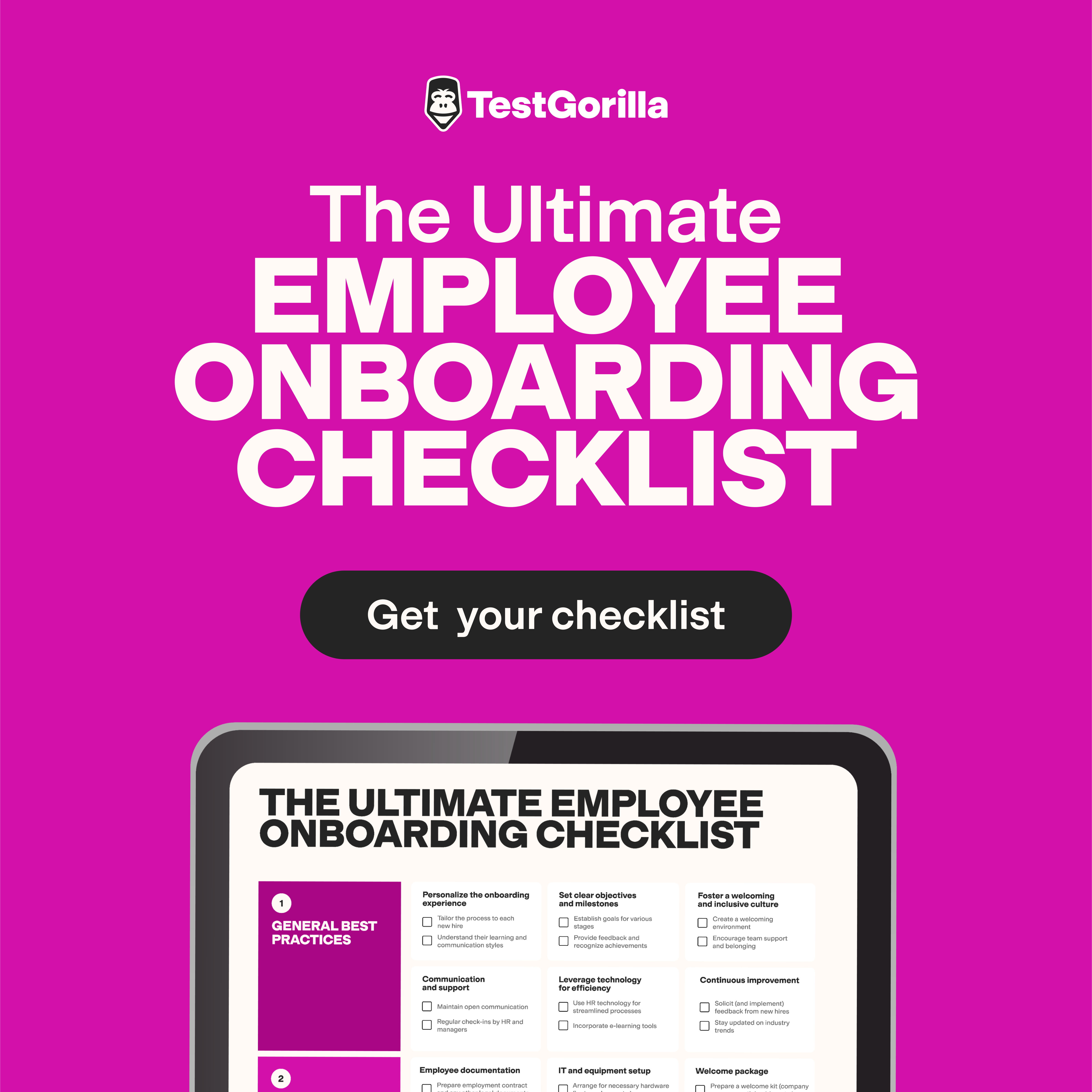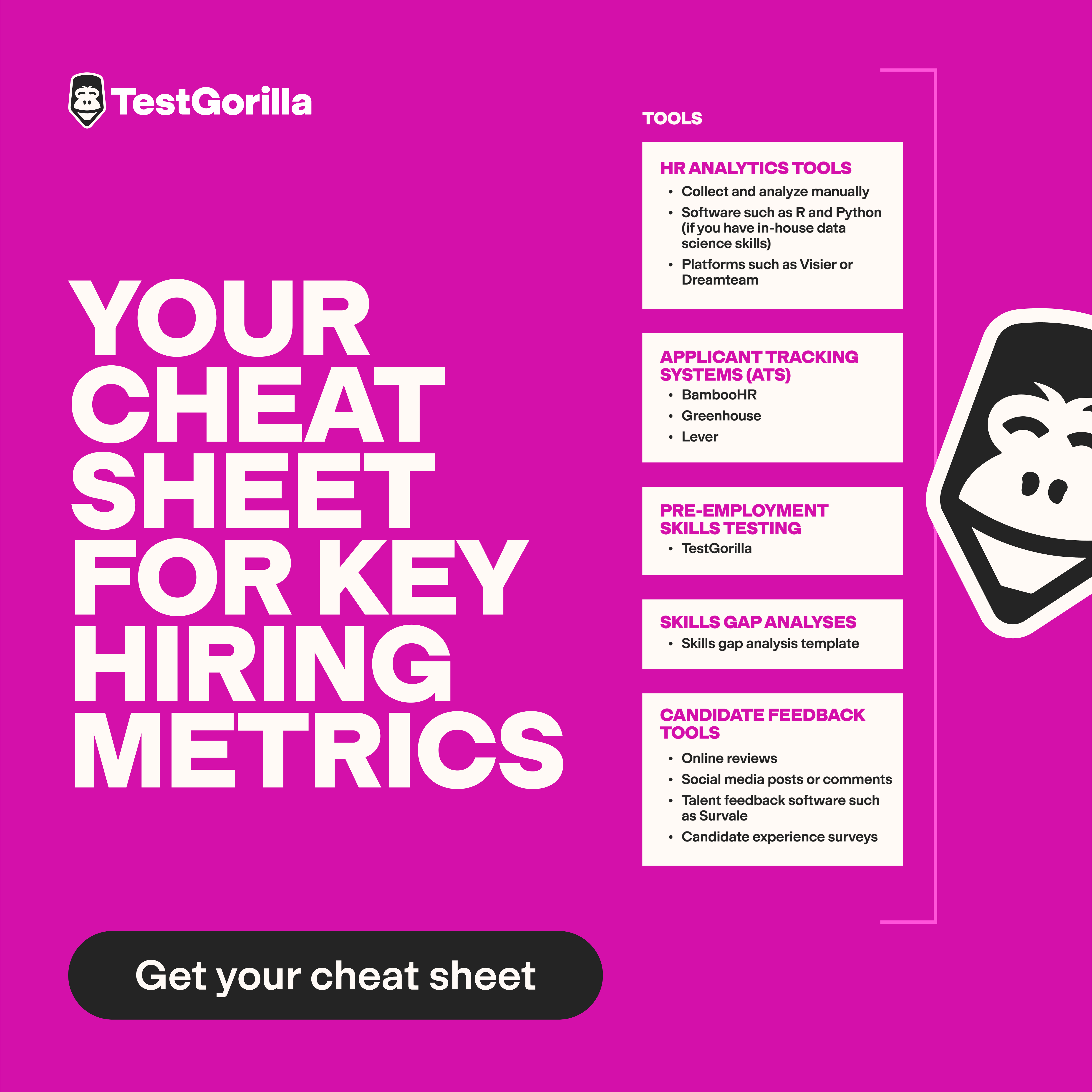Candidate screening: Leverage this acquisition strategy and hire top talent faster
Candidate screening is essential when hiring new workers, especially when each open role gets hundreds or even thousands of applications.
It’s hard finding the right person in such a large pool – one study found that 76% of hiring managers have admitted to making a mis-hire. These mis-hires amount to wasted time and money, increased stress, and a negative impact on team morale.[1]
Employers need a proven method to confidently move candidates with the right skills forward and let unsuccessful job seekers down gently.
There are many ways to screen candidates, and every HR professional is on the lookout for the talent acquisition strategy that helps them zero in on better candidates faster.
This guide explores this subject, reviewing the top ways for screening candidates and confronting the big question of “quality of hire vs. time to hire.”
It also covers the top strategies for leveraging the most effective candidate screening method: skills-based hiring.
Table of contents
- What is candidate screening?
- Why is candidate screening important?
- What methods can you use for screening candidates?
- The challenge: Quality vs. time when screening candidates
- The solution: Turn to skills-based candidate screening
- 6 best practices for leveraging modern candidate screening practices to source top talent
- 3 examples of companies succeeding with skills-based candidate screening as a talent acquisition strategy
- Streamline candidate screening with talent assessments
What is candidate screening?
Candidate screening is the process of reviewing applications from job seekers. It usually involves scanning resumes, going through applications, and using talent assessments to find a candidate with the right skills, competencies, and traits.
Reviewing resumes is the top method for screening and evaluating candidates, but it’s only been that way for about 100 years.
This is starting to change. Increasingly, more companies are seeing the flaws of screening resumes, realizing that technology has provided us with other ways to assess quality.
Our report shows that more than 94% of employers believe talent assessments are more predictive of job success than resumes.
Modern screening techniques help you more easily identify suitable candidates in your talent pipeline. They also help you tackle talent acquisition trends like assessing behavioral competencies, which is impossible with only a candidate’s resume.
What steps are involved in a typical candidate screening process?
A candidate screening checklist usually follows a three-step process, from checking off the basics defined in your hiring plan to matching the candidate’s personality and culture to your company.
Let’s take a closer look.
1. Check off the basic requirements
First, look for the basics – does the candidate have the bare necessities to complete the role?
Basic requirements include:
Skills and competencies: The main job requirement to look for. Candidates need skills to complete role responsibilities.
Location: It’s important to check if the candidate is in the right location, whether or not they can relocate, or if they can work remotely if the role calls for it.
Salary expectations: The candidate’s salary expectations must match what you can offer.
Legal criteria: Confirm the candidate is legally allowed to work for you.
Relevant experience: Experience is a top concern for many companies, but it’s not always necessary.
2. Examine for preferred skills and qualifications
Next, you need to examine preferred qualifications. These move beyond the basics and go into qualifications that make a candidate more suitable than others.
Here are some common preferred qualifications:
Education: This is important to many hiring managers, but formal education isn’t usually required for most roles. Note: This may be a basic requirement for roles that require a certain educational background, like medical or legal positions.
Achievements: Many employers want to see the tangible results the candidate has achieved.
Job tenure: Many employers want to see workers who have stayed in one role for a long time, showing they aren’t a job-hopper.
Culture add: It’s important to match the candidate to your company in terms of core values and what they contribute to your company culture.
A match with the job description: It’s great when a candidate aligns with a job description, although many hiring managers are now making it a “nice to have.”
3. Match the candidate holistically to the role
In the final step of the candidate selection process, you need to bring all the information together and look at the candidate as a whole. Do they suit the role, your team, and your company?
This means you must look at all the previous points and consider crucial elements like culture add, communication skills, and motivators.
For example, a candidate may have every qualification on your checklist, but if they thrive in an independent environment and your company is highly collaborative, it might not work out.
Why is candidate screening important?
Candidate quality is a tricky issue, and increasingly more hiring managers are struggling to shortlist top talent.
More methods for screening job candidates have been cropping up to try to alleviate the strain on hiring managers and help them secure qualified candidates.
Candidate screening and assessment have always been important, but it’s imperative due to factors like the “apply anyway” trend, which encourages anybody to apply for a job.
This trend isn’t always negative. It’s a positive trend for candidates who have the skills but not the formal certifications – but it’s a time-consuming drain on hiring managers when they get flooded with applicants who don’t have the skills.
This flood of prospects increases the chances of mis-hires and reduces hiring speed.
One survey found that 82% of respondents believe a more efficient candidate screening process can combat this and improve hiring speed. A further 87% believe that more timely feedback from hiring managers can also improve this.
Timely feedback is much easier to give when the hiring manager has an effective picture of the candidate’s quality and an efficient way to deliver the information.
A variety of candidate screening tools can help with this, so let’s take a look next.
The best insights on HR and recruitment, delivered to your inbox.
Biweekly updates. No spam. Unsubscribe any time.
What methods can you use for screening candidates?
There are many different methods to gauge candidate quality, including screening resumes, interviewing applicants, and leveraging talent acquisition technology like talent assessments.
Here are the most popular methods for screening candidates that we’ll be taking a look at:
Resumes and cover letters
Application forms
One-way video interviews
Phone calls
Social media
Talent assessments
Trial projects
Interviews
Background checks
1. Resumes and cover letters
Resumes and cover letters are documents that summarize the professional experience, skills, and education of job seekers. They gained popularity in the 1930s as a quick way to determine if a candidate had the right qualifications for the role.
Recruiters used to scan resumes by hand, but now many companies use applicant tracking systems with resume screening tools.
Pros:
Gives you an easy-to-read summary of skills and experience
A tried-and-true method for hiring managers are
Cons:
Unreliable
Easy to lie
Enables unconscious bias
What to look for when screening:
Skills front and center
Professionally formatted
Clear relevance to the role
2. Application forms
Job application forms are documents with questions deemed relevant to the role by employers.
They help hiring managers quickly shortlist candidates by sorting out people who don’t fit the right criteria.
Pros:
You can quickly sort candidates if you have highly specific criteria, such as “must have a Class B driver’s license”
Can easily be made anonymous to prevent hiring bias
Cons:
Enables unconscious bias (if you don’t anonymize them) because forms usually ask for gender, age, and name
Isn’t always a reliable indicator of quality
What to look for:
Candidates who suit your must-haves, keeping an open mind about smaller details like experience
3. One-way video interviews
One-way video interviews are short videos that candidates film and send to employers. They’re an opportunity to quickly list skills, achievements, and experience by mouth instead of on a document.
Pros:
Helps display general communication skills
Some candidates prefer to verbally discuss their skills and experience
Helps candidates display certain role-specific skills like sales negotiation
Cons:
Some candidates are uncomfortable with video, which means that even if they’re highly qualified, they might flunk the video or avoid it entirely
Some candidates don’t possess the technology or technical skills to film a short video
What to look for:
Preparedness
Soft skills like communication
4. Phone calls
This screening method is a short phone interview, usually 15 to 30 minutes, where a recruiter aims to learn more about a candidate, such as digging deeper into their background and skills.
Pros:
A good option for candidates who don’t prefer video
Nearly everyone has a phone, making the process more inclusive
Cons:
It isn’t the most reliable way to connect with candidates or learn about them
Many recruiters rely on body language, which is non-existent over the phone
What to look for:
Consistency with their prior claims – candidates who were lying on their resumes may not be prepared for certain questions
5. Social media
Social media screening is the process of researching candidates’ social media presence to learn about them. This candidate screening method helps hiring managers learn about a job seeker’s behavior and interests.
Pros:
Helps you find inappropriate behavior that may not be acceptable at your company
Reveals real-world talent for marketing roles because a strong online presence shows skills in this field
Cons:
It isn’t always best to judge a person’s behavior when they aren’t in a professional setting
Candidates may feel this is a breach of their personal privacy
What to look for:
For marketing roles, look for a strong online presence and the right tactics to attract and retain an audience
6. Talent assessments
Talent assessments are tests that gauge a person’s hard and soft skills, behavioral competencies, and culture. This method enables hiring managers to focus on abilities rather than a candidate’s background, education, or work experience.
Most commonly, these tests are delivered through candidate screening software.
Pros:
An accurate picture of real skills
Easily gauges cultural alignment
Drastically reduces unconscious bias
You can drop unnecessary requirements like college degrees
Cons:
A relatively new method that not every leader will buy into
Some companies can’t justify the cost
What to look for:
Candidates who meet or exceed your benchmark scores
The right core culture values
7. Trial projects
Trial projects, also called job trials or trial samples, are small samples of realistic work tasks that determine a candidate’s skills. A few common examples are a sample essay for writers or a coding test for programmers.
Pros:
Tests real skills
Affordable to issue
A great way to evaluate contingent workers
Cons:
Not every company has the resources to build and assess trials manually
Some skilled candidates may not be willing to devote time to a trial, especially if it’s unpaid
What to look for:
Candidates who not only complete trials skillfully, but also in accordance with your guidelines – e.g., brand voice for writers
8. Interviews
Job interviews are a conversation between the interviewer and the candidate with the aim to assess the applicant’s suitability for the position. Interviews can be in-person or online and can be unstructured or structured.
Unstructured interviews usually have little plan, and structured interviews have pre-planned criteria and a script.
Pros:
A chance to get to know a candidate
If you’re using a structured interview process, you have a script and pre-determined success criteria
Cons:
Many candidates get nervous during video or in-person interviews even when they’re qualified
Many candidates are good at showing their confidence and charisma even when they aren’t qualified, leading to mis-hires you might not catch until way after onboarding
Unstructured interview questions are inconsistent and full of opportunities for bias
What to look for:
Candidates that answer based on your success criteria
9. Background checks
Background checks are a practice where employers collect private and public records to gauge a candidate’s employability. Recruiters conduct a variety of different background checks, depending on the role relevance, including credit history and driving records.
Pros:
Enables employers to verify crucial qualifications, such as medical degrees
Helps you uncover criminal history
Having a regular background check process helps when it’s required by law
Cons:
Could lead to bias around criminal history or drug use when it isn’t relevant to the role
Care must be taken to avoid breaking the law – in many areas, it’s illegal to conduct background checks before making an offer
What to look for:
Criminal history in a relevant field, such as looking for a history of violence towards children when hiring for a teaching role
The challenge: Quality vs. time when screening candidates
One of the largest challenges when screening and evaluating candidates is balancing these competing metrics: candidate quality and time to hire.
Many HR professionals find an imbalance in these metrics when using talent acquisition analytics, and it’s easy to see why.
Essentially, every day an open position isn’t filled, it’s costing the company money. This puts pressure on the hiring manager to fill a role quickly. On the other hand, if you fill a role too quickly, you could misjudge the candidate, overlook red flags, and pass over quality applicants.
Some hiring managers also use recruiting automation to scan resumes for keywords and speed up the process, but this also negatively affects quality. Even worse, mishandling AI candidate screening to improve speed can cause discrimination.
Juggling these metrics is more than a headache; it impacts your recruitment budget, workforce quality, and employer branding.
To combat this delicate situation, you need the right candidate screening tools.
The solution: Turn to skills-based candidate screening
The best way to balance time to hire and candidate quality is by relying on skills-based hiring methods.
The top skills-based methods being used to screen job seekers are:
Talent assessments
Job trials
Structured interviews
Skills-based practices equip you with objective methods to accurately gauge candidate quality, while also improving time to hire.
According to The State of Skills-Based Hiring 2024, of thoseorganizations using skills-based hiring:
90% saw a reduction in mis-hires
81% reduced time to hire
78% reduced cost to hire
Skills-based hiring empowers you to be faster, more accurate, and hire with less bias – which means you gain access to a wider talent pool with more qualified candidates.
Here’s an example candidate screening process:
Send talent assessments to job seekers
Review the results and sort them by test score
Shortlist candidates and invite the successful contenders to structured interviews
Issue trial projects to the best prospects (optional, depending on the role)
Skills-based practices, particularly talent assessment tests, enable you to confidently hire the right person for the role in less time.
Next, we’ll look at a few best practices for screening candidates the skills-based way.
6 best practices for leveraging modern candidate screening practices to source top talent
Skills-based candidate screening and assessment is a winning strategy to boost quality and speed, but there’s more to it than finding the right software tool.
You get more out of skills-based methods and platforms by leveraging the right strategies, so let’s dive into them.
Strategies for skills-based candidate screening: A summary
Strategies | Description |
1. Enforce fair hiring practices | Go beyond talent assessments, break down barriers, and ensure your entire hiring process is inclusive |
2. Use a mixture of skills tests in your assessments | Leverage multi-measure testing to gauge a candidate’s hard skills, soft skills, and personality |
3. Use culture add assessments to gauge the whole candidate | Evaluate cultural alignment with culture add to avoid the issues with culture fit but still determine how well a person works with your company |
4. Use job application forms before talent assessments | Use applications to determine necessary criteria like medical degrees before issuing talent assessments |
5. Toss out reliance on resumes | Remove resumes from the hiring process and rely on talent assessments to improve efficiency and reduce bias |
6. Use video screening after talent assessments | Use one-way video interviews after talent assessments to get a picture of a candidate’s skills first |
1. Enforce fair hiring practices
Skills-based hiring works best when you adopt wholly inclusive hiring practices.
Fair hiring practices aim to reduce barriers between qualified candidates and job positions, and talent assessments are only one of the many ways to practice inclusive recruitment.
This leads to higher quality employees and more diverse candidates.
Here are a few best practices to promote fair hiring:
Stop relying on resumes
Adopt special accommodations to ensure disabled candidates get screened fairly
Consider diverse sourcing channels and job boards
Keep your screening criteria and strategies consistent across candidates
That last point refers to scoring benchmarks. Knowing where to set the bar is an important strategy. With talent assessments, you set this as a percentage in each skills test. This depends on the role because some positions may only require candidates to score 70% and some may need 80%.
With other screening methods, like structured interviews, this approach requires you to determine criteria for success and stick closely to them with each candidate you interview.
2. Use a mixture of skills tests in your assessments
One of the main mistakes people make when using talent assessments is excluding key tests that gauge personality and culture.
Don’t only test hard skills – assess a variety of skills. This is called “multi-measure testing” and involves adding technical skills tests, soft skills tests, and personality tests into an assessment.
These tests reveal key traits and competencies, like a candidate’s work style and adaptability. Certain tests, like the Enneagram test, gauge a candidate’s worldview and conflict resolution.
Here’s an example of a multi-measure assessment:
Python test
Javascript test
Problem Solving test
Attention to Detail test
Culture Add test
All of these are available in our test library.
However, always ensure the qualities you gauge are role-relevant. For example, you shouldn’t assess a backend developer’s teamwork skills just because you like “team players” – if they won’t be working with others often, it isn’t relevant.
3. Use culture add assessments to gauge the whole candidate
Cultural alignment has long been a part of candidate screening questions for recruiters, usually during phone screening or job interviews.
This alignment is crucial to make sure a candidate works well with a company, helping to build a good company culture. It also helps predict future motivation and engagement.
However, the traditional way to assess this is through culture fit, which is problematic at best. Culture fit looks for similar people and “fits” them into a workplace, leading to potential discrimination and groupthink.
Culture add, on the other hand, gauges core values like learning and trust, while still encouraging diverse beliefs and behaviors.
We evaluate this by first issuing you a questionnaire, asking which values are most important to your company. Then, you add the test to assessments and send them to your candidates.
Here’s a look at some sample results from our Culture Add test:
The results show you the values the candidate chose as important and how they relate to the values you find important.
This gives you a holistic view of the candidate. Rather than reviewing a simple collection of skills and experiences, you can evaluate their core motivators and how they work best.
4. Use job application forms before talent assessments
Some skills-based hiring processes get rid of applications entirely, opting instead to fully rely on talent assessments and interviews.
However, if you choose to keep them, always ensure they come before talent assessments.
Have your potential candidates fill out applications and answer qualifying questions to first determine essential certifications, like specific driver’s licenses, medical degrees, or engineering degrees.
This helps you quickly and efficiently shortlist applicants without resorting to bias-filled candidate screening methods like automatically scanning resumes.
However, even if you’re using application forms, we strongly recommend you don’t use resumes or cover letters in your process.
We’ll discuss that next.
5. Toss out reliance on resumes
When you use talent assessments, you don’t need to rely on inaccurate screening methods like resumes.
Screening and evaluating candidates by skimming resumes uses extra time and money, especially when leveraging resume screening software. It’s also unreliable at best because many people lie on their resumes.
Resumes can even reduce hiring efficiency due to wasted time and bad hires.
Talent assessments give you an accurate picture of a candidate’s qualifications, so you don’t need to mess with resumes anymore. You can toss them out of your hiring process and rely on something more effective.
This leads to higher candidate quality and reduced mis-hires, as well as eliminating most unconscious bias.
6. Use a video screening interview after talent assessments
One-way video interviews are a screening tool used by some companies before candidates go into a live structured interview. They’ve replaced telephone interviews in many companies.
They’re also common when hiring remote employees.
Many organizations structure these in the early stages of online candidate screening, but we suggest they come a step or two later.
Issue video interviews after talent assessments to get a more complete picture of your candidates. This way, you can avoid making snap hiring decisions or forming biased opinions.
You wouldn’t want to judge a candidate based on an awkward video interview when they’re an excellent programmer – you just don’t know it yet.
Use talent assessments first to narrow it down to the best, and then use video screening to decide who to interview in combination with the skill assessment results.
3 examples of companies succeeding with skills-based candidate screening as a talent acquisition strategy
Organizations are seeing great success in screening and evaluating candidates with skills-based methods, reducing time to hire, increasing employee retention, and filling difficult positions.
Here are three companies succeeding with skills-based candidate screening.
Companies using skills-based candidate screening: A summary
Company | Why it’s successful |
Revolut | Uses language assessments to reduce time to hire |
Consensys | Leverages technical assessments to hire for difficult-to-fill blockchain roles |
LILAB | Relies on multi-measure testing to improve new employee retention rate |
Revolut
Revolut, a British-Lithuanian financial services company, spent far too much time on its manual hiring process.
Being a European business, this company needs to assess language skills as a normal part of the recruitment process to verify candidates can speak the necessary languages and speak them at the right proficiency level.
However, to do this right, the hiring team needed to process language essays manually, wasting hours of valuable time.
Then, the team adopted TestGorilla’s talent assessments to automate language assessment, streamlining language tests and freeing up recruiter time for more important tasks.
The switch to talent assessments improved Revolut’s time to hire by 40%. It also improved the candidate experience, leading more applicants to finish their language assessments.
Consensys
Consensys, a blockchain company, needs to devote a lot of time to ensure each candidate is qualified. It regularly fills highly specialized roles, and determining suitability is incredibly difficult.
This company used to spend more than 20 hours of time hiring for a single role, but it cut that down by using talent assessments to easily find and shortlist top candidates.
Consensys built custom technical assessments for different specialized roles, including junior, mid-tier, and senior roles. These custom assessments enable them to hire for niche skills quickly and easily.
Gabriel Ranta, the talent lead at Consensys, says the company gets the “best of both worlds,” reducing time to hire while improving candidate quality. He also says that candidates love displaying their talent in an engaging manner.[2]
LILAB
Lima Innovation Lab (LILAB), a software company, had a difficult roadblock standing in the way of its recruitment process.
This company had issues with its candidate screening process due to needing highly technical roles but having hiring managers who lacked technical knowledge.
Because hiring managers couldn’t accurately determine candidates’ skills, it led to unqualified candidates getting through the process, and LILAB had a large dismissal rate because of it.
Its team then adopted TestGorilla and started using talent assessments. It leverages multi-measure assessments by combining technical tests, personality tests, and custom tests that the LILAB built to assess company-specific needs.
The results were outstanding – LILAB saw an increase in new employee retention by up to 90%.
Assessing real skills enables this company to push more qualified candidates to the final stages of hiring so only the best applicants get through, which increases retention because these new employees suit their roles.
Streamline candidate screening with talent assessments
Screening candidates is an essential part of your talent acquisition strategy, so you need to consider your options with care.
Resume screening may be the norm, but skills-based methods for screening candidates, like using talent assessments and job trials, are more reliable.
Balancing time to hire and candidate quality is tricky, but skills-based hiring helps you do it.
Skills-based methods are most effective when you adopt best hiring practices, use pre-employment testing, and assess culture add.
These best practices also help improve how job seekers perceive your recruitment process. For more information on this topic, read our guide on improving the candidate experience.
To learn more about how to gauge cultural alignment with skills-based hiring, check out our Culture Add test.
Sources
"Hiring Mistakes Come At A Higher Price Amid Pandemic". (March 16, 2021). PR Newswire. Retrieved November 29, 2023. https://www.prnewswire.com/news-releases/hiring-mistakes-come-at-a-higher-price-amid-pandemic-301248107.html
"How Consensys Is Using Vervoe To Identify And Attract Highly Skilled Talent". Vervoe. Retrieved November 29, 2023. https://vervoe.com/customers/consensys/
You've scrolled this far
Why not try TestGorilla for free, and see what happens when you put skills first.


